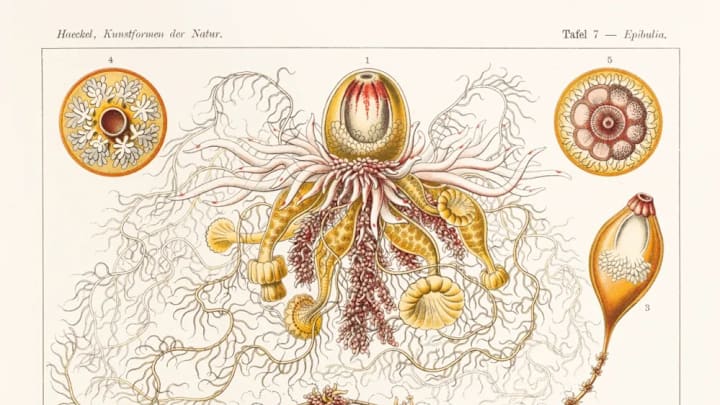His artworks showed the wonders of evolution to a wide audience.
"Nature generates from her womb an inexhaustible plethora of wonderful forms," wrote the German biologist and artist Ernst Haeckel, "the beauty and variety of which far exceed the crafted art forms produced by human beings." Haeckel, born in 1834, was deeply influenced by the work of naturalist/explorer Alexander von Humboldt, who argued that nature should be studied using both scientific and aesthetic judgment. Later, after reading Charles Darwin's On the Origin of Species, Haeckel endeavored to show the wonders of evolution to a wide audience. His paintings of swirling jellyfish, geometric radiolaria, sensual orchids, and animated hummingbirds, collected in his 1904 masterpiece Kunstformen der Natur (Art Forms in Nature), revealed the interconnectedness of art and the natural world. Many artists used these motifs as the foundation of the Art Nouveau style.
A new book, The Art and Science of Ernst Haeckel (Taschen), assembles 450 stunning examples from Haeckel's many published works, including the plates in this gallery. As editors Rainer Willmann and Julia Voss write in its introduction, "Haeckel’s illustrated publications repeatedly called forth one reaction above all others: incredulous astonishment at the beauty of objects to be found in nature."
1. CNIDARIA-SIPHONOPHORA

Siphonophores are colonial organisms in the phylum Cnidaria, which includes jellyfish, corals, and sea anemones.
2. CNIDARIA

These jellyfish belong to the phylum Cnidaria. Haeckel named Desmonema annasethe (center) for his first wife shortly after her death.
3. CNIDARIA-SIPHONOPHORA

This plate shows a selection of siphonophores in the phylum Cnidaria. All of these organisms were discovered and named by Haeckel.
4. CNIDARIA-SCYPHOZOA

This plate displays true jellyfish of the class Scyphozoa.
5. ECHINODERMATA-ECHINOIDEA

These sea urchins belong to the phylum Echinodermata, class Echinoidea.
6. VERTEBRATA-ACTINOPTERYGII

These ray-finned fishes belong to the class Actinopterygii.
7. MOLLUSCA-CEPHALOPODA-AMMONOIDEA

Spiral-shelled ammonites are a group of extinct marine mollusks in the subclass Ammonoidea.
8. CNIDARIA-ANTHOZOA

This plate shows a colony of sea anemones, or "flower-like animals," in the class Anthozoa.
9. MOLLUSCA-GASTROPODA

This plate shows the shells of a group of marine snails in the class Gastropoda, which also includes slugs.
10. ANGIOSPERMAE-NEPENTHACEAE

This group of tropical pitcher plants in the family Nepenthaceae are carnivorous.
11. AMPHIBIA

This plate reveals the similarities of frogs in the class Amphibia.
12. MUSCINAE

In Haeckel's time, these mosses were termed Muscinae. Now they are classified in the division Bryophyta.
13. ANGIOSPERMAE-ORCHIDACEAE

This plate shows examples of orchids in the family Orchidaceae, one of the largest families of flowering plants.
14. TUNICATA

Tunicates are marine invertebrates belonging to the subphylum Tunicata.
15. SAUROPSIDA-AVES

The class Aves includes tropical hummingbirds.
